A Side-by-Side Comparison of Leading Steel Coil Packing Line Technologies
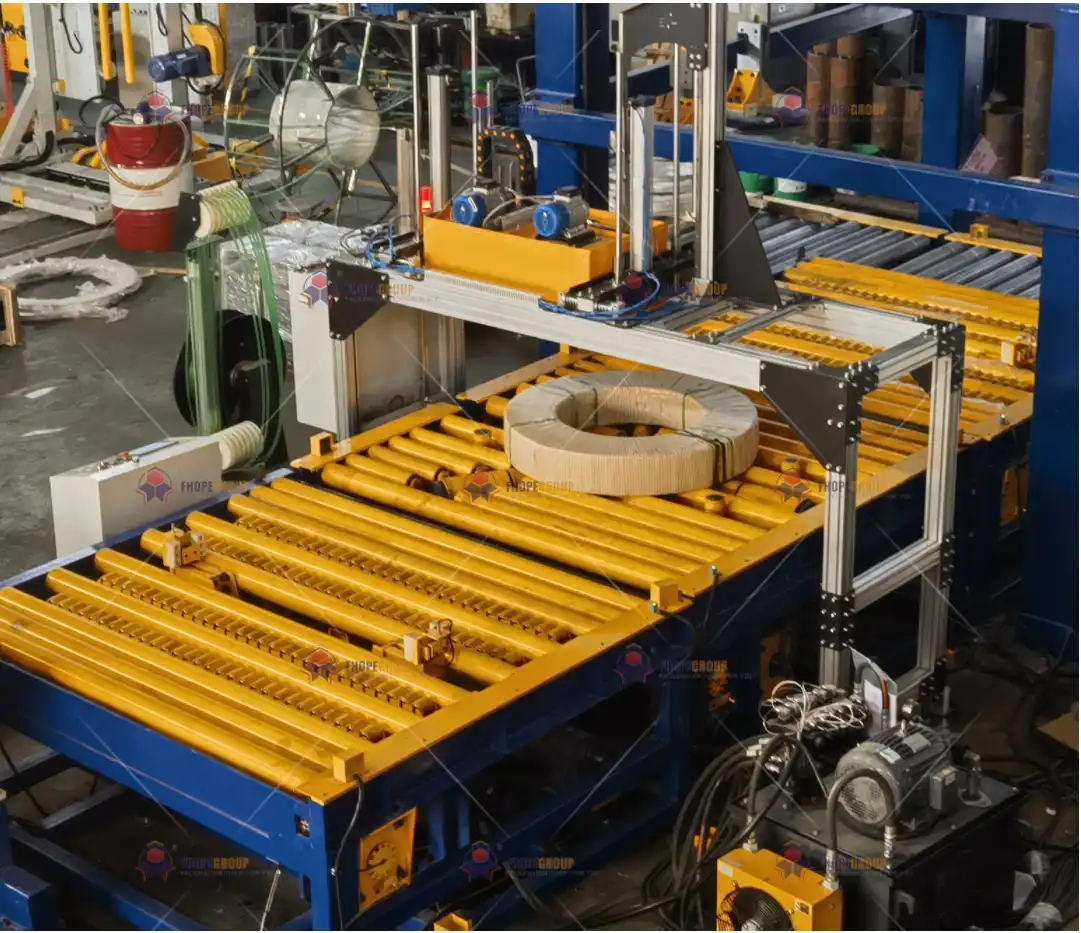
Introduction
In the demanding world of steel manufacturing, maximizing efficiency, ensuring product integrity, and maintaining worker safety are critical priorities. A crucial stage in the production process is the packing of steel coils. This involves applying protective materials and securing the coils for safe transport and storage. With continuous technological advancements, steel producers now have access to a diverse range of steel coil packing line technologies. Choosing the right system can significantly impact operational efficiency, costs, and safety.
This article provides an in-depth, side-by-side comparison of the leading technologies available for steel coil packing. We will explore the operational principles, advantages, and limitations of manual, semi-automated, and fully automated systems. Whether you are an experienced industry professional evaluating an upgrade or new to optimizing steel coil handling, understanding these technological differences is key to making an informed decision that best suits your specific production environment and goals.
1. Understanding Steel Coil Packing Essentials
Before comparing specific technologies, it's important to understand the fundamental requirements of steel coil packing. Steel coils, which are essentially large rolls of sheet steel, must be carefully packaged to prevent damage from moisture, physical impact, and corrosion during handling, transportation, and storage. Effective packing maintains the quality and usability of the steel upon arrival at its destination.
Key Factors in Evaluating Steel Coil Packing Technologies
When assessing different packing line solutions, several critical factors should guide your decision:
- Safety: Protecting personnel from hazards associated with handling heavy coils and operating machinery is paramount. The chosen technology must minimize injury risks.
- Speed and Throughput: The efficiency of the packing line directly impacts overall production capacity and lead times. Faster, more reliable systems contribute significantly to operational performance.
- Cost-Effectiveness: This involves balancing the initial capital investment against long-term operational savings derived from increased productivity, reduced labor, lower material waste, and decreased product damage.
- Flexibility and Adaptability: The system should ideally accommodate variations in coil dimensions (width, diameter) and weight with minimal downtime or manual adjustments.
- Packaging Quality and Protection: The technology must consistently apply protective materials (like VCI paper, stretch film, edge protectors) effectively to safeguard the coil according to required specifications.
- Maintenance Requirements: Consider the ease of maintenance, availability of spare parts, and potential downtime associated with each system type.
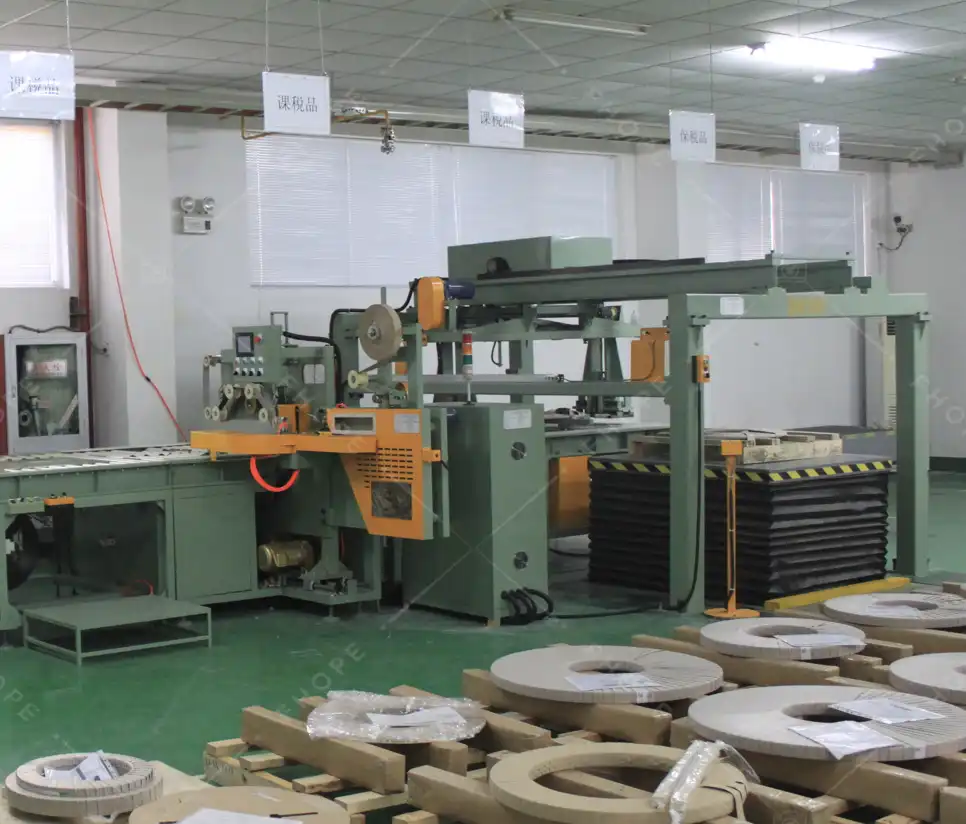
steel coil packing line(1) 2. Overview of Steel Coil Packing Technologies
Steel coil packing solutions generally fall into three main categories based on their level of automation:
a. Manual Packing Systems
Manual packing systems rely entirely on human operators to perform all packing tasks, including material application, wrapping, and strapping. This traditional method requires minimal initial investment in equipment.
Advantages:
- Low Initial Cost: Significantly lower upfront capital expenditure compared to automated options.
- High Flexibility: Human operators can easily adapt to varying coil sizes, weights, and specific customer packing requirements without reprogramming.
- Simple Setup: Requires less complex installation and infrastructure.
Disadvantages:
- Labor-Intensive: High dependency on manual labor leads to higher ongoing operational costs and potential workforce availability issues.
- Inconsistent Quality: Packing quality can vary significantly depending on operator skill, fatigue, and attentiveness.
- Slower Throughput: Manual processes are inherently slower than automated ones, limiting overall production capacity.
- Higher Safety Risks: Involves direct manual handling of heavy coils and packing materials, increasing the risk of musculoskeletal injuries and accidents.
b. Semi-Automated Packing Systems
Semi-automated packing systems integrate machinery to handle specific, often repetitive or physically demanding tasks, while still requiring operator involvement for certain steps like material loading, system oversight, or final checks. Examples include automated wrapping stations or strapping machines integrated into a line where coils are manually positioned or moved.
Advantages:
- Improved Speed and Efficiency: Automating key tasks significantly increases packing speed compared to purely manual methods.
- Enhanced Consistency: Machines perform tasks uniformly, leading to more consistent packaging quality and material usage.
- Reduced Physical Strain: Lessens the manual labor burden on operators, improving ergonomics and safety for strenuous tasks.
- Moderate Investment: Offers a balance between the low cost of manual systems and the high investment of full automation.
Disadvantages:
- Higher Initial Cost than Manual: Requires a greater capital investment for machinery purchase and integration.
- Operator Training: Personnel need training to operate and potentially troubleshoot the equipment effectively.
- Maintenance Needs: Machinery requires regular preventive maintenance, increasing ongoing operational tasks and potential downtime compared to manual systems.
- Potential Bottlenecks: Throughput can be limited by the speed of the remaining manual steps in the process.
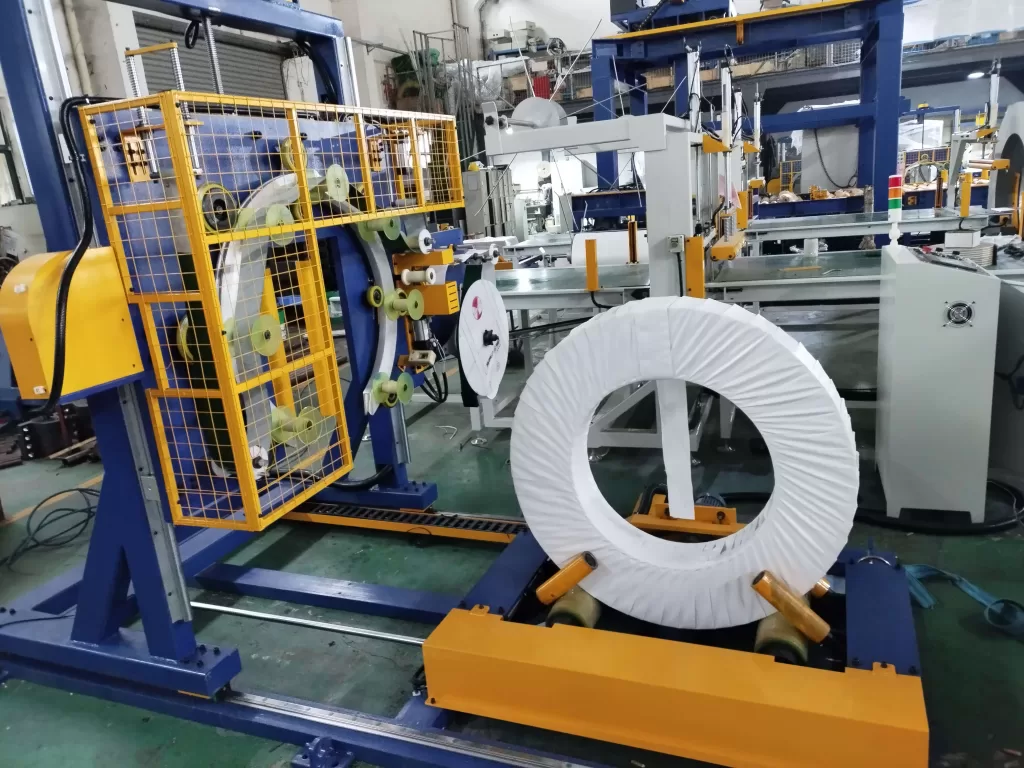
steel packing machine5 3. Fully Automated Packing Systems
Fully automated packing systems utilize advanced robotics, conveyors, sensors, and integrated control systems (PLCs) to perform the entire packing sequence with minimal or no direct human intervention. Operators typically monitor the system and handle exceptions or material replenishment.
Advantages:
- Maximum Throughput and Efficiency: Capable of continuous, high-speed operation (24/7), significantly boosting packing capacity.
- Superior Consistency and Quality: Precise robotic movements and automated controls ensure highly uniform application of packing materials and securement, minimizing damage risk.
- Optimized Material Usage: Programmed control leads to efficient use of wrapping film, paper, and straps, reducing waste.
- Enhanced Safety: Dramatically reduces direct human interaction with heavy coils and moving machinery, significantly lowering accident risks.
- Lower Long-Term Labor Costs: Reduces the need for manual labor, leading to substantial savings over the system's lifespan, especially in high-wage areas.
Disadvantages:
- Highest Initial Investment: Requires significant capital expenditure for equipment, installation, and integration.
- Complexity: Sophisticated systems demand skilled technicians for programming, maintenance, and troubleshooting.
- Less Flexibility (Potentially): While modern systems are increasingly adaptable, handling highly non-standard or frequently changing coil dimensions might require reprogramming or specific tooling, potentially impacting flexibility compared to manual methods.
- Space Requirements: Often requires considerable floor space and specific facility layouts for optimal operation.
4. Key Considerations When Choosing Your Packing Technology
Selecting the optimal steel coil packing technology requires a careful evaluation of your unique operational context. Consider these critical factors:
a. Production Volume and Speed Requirements
Analyze your current and projected output. High-volume operations processing many coils per shift typically gain the most significant ROI from fully automated systems due to speed and efficiency. Lower to medium-volume facilities might find semi-automated systems offer the best balance of cost and performance, while very low volume or highly specialized needs could still be met manually.
b. Coil Variety and Packing Specifications
Assess the range of coil sizes (inner/outer diameter, width) and weights you handle. If you process highly standardized coils, automation is often straightforward. If you handle a wide variety of sizes or have complex, frequently changing customer packing requirements, ensure the chosen automated or semi-automated system offers the necessary flexibility and ease of changeover.
c. Available Space and Facility Layout
Evaluate the physical footprint available for the packing line. Fully automated systems often demand significant, well-organized space. Ensure your facility can accommodate the chosen system's layout, including conveyor paths, robotic work envelopes, and safety zones. Semi-automated and manual setups generally offer more layout flexibility.
d. Integration with Existing Systems
Consider how the new packing line will connect with upstream (e.g., slitting line, annealing) and downstream (e.g., warehousing, shipping) processes. Seamless integration, often involving data communication between PLCs or connection to Manufacturing Execution Systems (MES), is crucial for overall plant efficiency. Compatibility with existing cranes, coil cars, or AGVs is also vital.
e. Budget and Return on Investment (ROI)
While initial cost is a major factor, evaluate the total cost of ownership, including installation, training, labor, materials, maintenance, and potential downtime. Calculate the expected ROI based on projected gains in throughput, labor savings, material cost reduction, improved quality (less damage/rework), and enhanced safety.
f. Future Growth and Scalability
Select a system that can accommodate your anticipated business growth. Consider modular designs that allow for future expansion of capacity or capabilities (e.g., adding more wrapping options, vision inspection) without requiring a complete system replacement.
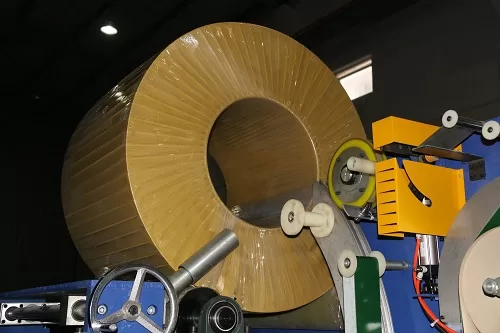
5. Comparative Analysis: Choosing the Right Fit
Let's summarize the core trade-offs:
a. Cost vs. ROI
- Manual: Lowest initial cost, highest ongoing labor cost, potential for higher damage/waste costs. ROI depends heavily on labor rates and volume.
- Semi-Automated: Moderate initial cost, reduced labor costs compared to manual, improved consistency. Often provides a strong ROI for medium-volume operations.
- Fully Automated: Highest initial cost, lowest long-term labor cost, potential for best material efficiency and quality consistency. Typically offers the best ROI for high-volume, stable production environments.
b. Speed & Throughput
- Manual: Slowest, limited by human capability and fatigue.
- Semi-Automated: Significantly faster than manual, throughput often dictated by the speed of both automated and manual components.
- Fully Automated: Fastest, capable of continuous high-speed operation, maximizes plant capacity.
c. Flexibility & Customization
- Manual: Highest flexibility, easily adapts to unique or infrequent requirements.
- Semi-Automated: Moderate flexibility, can handle variations but may require adjustments.
- Fully Automated: Can be highly flexible if designed for it, but may require programming or tooling changes for significant variations outside the designed parameters.
d. Labor Requirements & Safety
- Manual: High labor requirement, highest exposure to safety risks (lifting, repetitive motion).
- Semi-Automated: Reduced labor requirement, improved safety by automating hazardous tasks.
- Fully Automated: Minimal direct labor requirement, highest level of safety by removing operators from hazardous processes.
6. Real-World Examples: Technology in Action
Case studies illustrate the tangible benefits of adopting appropriate packing technology:
a. Example 1: Large Integrated Steel Mill Transition
A major steel producer transitioned from a predominantly manual and semi-automated packing setup to a fully automated line for its high-volume galvanized coil products.
- Result: Achieved a 40% increase in packing throughput, significantly reduced labor costs per ton, improved packaging consistency leading to fewer transit damage claims, and enhanced overall plant safety metrics. The substantial investment showed a calculated ROI within approximately 2.5 years.
b. Example 2: Mid-Sized Service Center Upgrade
A steel service center handling diverse coil sizes upgraded from a purely manual process to a semi-automated line featuring an automated stretch wrapper and strapping station, while retaining manual control for initial coil positioning and final labeling.
- Result: Realized a 30% reduction in packing cycle time, improved package integrity, and reduced worker fatigue and injury risk associated with manual wrapping. The moderate investment provided a balance between enhanced efficiency and maintaining flexibility for varied orders.
7. The Critical Role of Technology in Enhancing Safety
Safety is a non-negotiable aspect of steel coil handling and packing. Automation plays a vital role in mitigating risks:
- Reduced Manual Handling: Automated systems minimize or eliminate the need for operators to lift, push, or manipulate heavy coils or packing materials, reducing risks of strains, sprains, and crush injuries.
- Machine Guarding & Sensors: Fully automated lines incorporate extensive safety features like physical barriers, light curtains, laser scanners, and emergency stop systems to protect personnel from moving machinery.
- Ergonomics: Even semi-automated systems improve ergonomics by taking over physically demanding tasks like stretch wrapping or band tensioning.
Regardless of the technology level, robust safety protocols, regular equipment inspections, and comprehensive operator training remain essential.
8. Environmental Considerations in Packing Technology
Sustainability is an increasingly important factor in operational decisions. Modern packing technologies can contribute to environmental goals:
- Material Optimization: Automated systems offer precise control over the application of stretch film, VCI paper, and strapping, minimizing material consumption and waste compared to manual applications.
- Energy Efficiency: Newer machinery often incorporates energy-efficient motors and drives. Evaluate the energy consumption profile of different systems.
- Waste Reduction: Consistent, high-quality packing reduces the likelihood of product damage, thereby preventing the waste associated with scrapped or reworked materials.
- Sustainable Materials: Consider technologies compatible with recyclable or biodegradable packing materials where feasible.
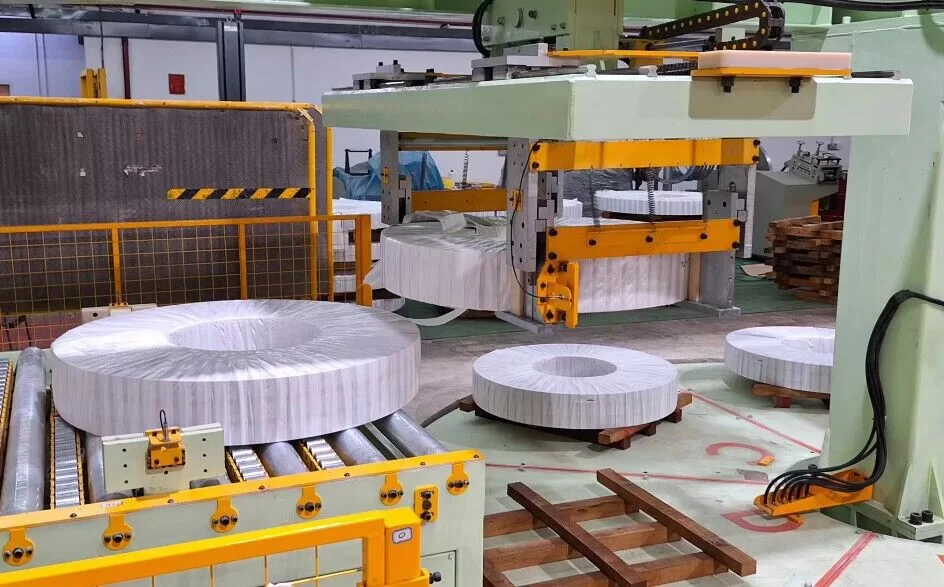
steel coil palletizing3 9. Future Trends in Steel Coil Packing Technology
The evolution of steel coil packing technology continues, driven by Industry 4.0 principles and the need for greater efficiency and intelligence:
- Increased Robotics & Cobots: More sophisticated robots, including collaborative robots ("cobots") designed to work safely alongside humans, are likely to become more common, offering flexibility in semi-automated environments.
- IoT Integration & Data Analytics: Sensors integrated into packing lines can collect real-time data on performance, material consumption, and machine health. Analyzing this data enables predictive maintenance, process optimization, and better quality control.
- Advanced Vision Systems: Machine vision can automate quality inspection checks, verify label placement, and ensure correct packaging configurations.
- AI-Driven Optimization: Artificial intelligence may be used in the future to dynamically optimize packing parameters based on coil characteristics and real-time line conditions for maximum efficiency and material savings.
- Focus on Sustainable Solutions: Continued development of both machinery and materials focused on reducing environmental impact will be a key trend.

steel wire packing machine with paper2 10. Conclusion: Making the Right Choice for Your Operation
Selecting the most suitable steel coil packing line technology is a strategic decision with long-term implications for efficiency, cost, safety, and quality. There is no single "best" solution; the optimal choice depends on a thorough assessment of your specific needs and operational context.
- Manual systems offer the lowest entry cost and high flexibility but come with significant drawbacks in terms of speed, consistency, labor cost, and safety.
- Semi-automated systems provide a balanced approach, improving efficiency and safety over manual methods at a moderate investment level, suitable for many medium-volume or varied production scenarios.
- Fully automated systems deliver the highest throughput, consistency, and safety, offering the best long-term ROI for high-volume, stable production environments, despite the substantial initial investment.
By carefully considering factors like production volume, coil variety, budget, space, integration needs, and future growth plans, steel manufacturers can choose the technology that best aligns with their operational goals. Embracing the right level of automation can significantly enhance competitiveness, ensure product quality during transit, improve workplace safety, and contribute to more sustainable manufacturing practices in the demanding steel industry.